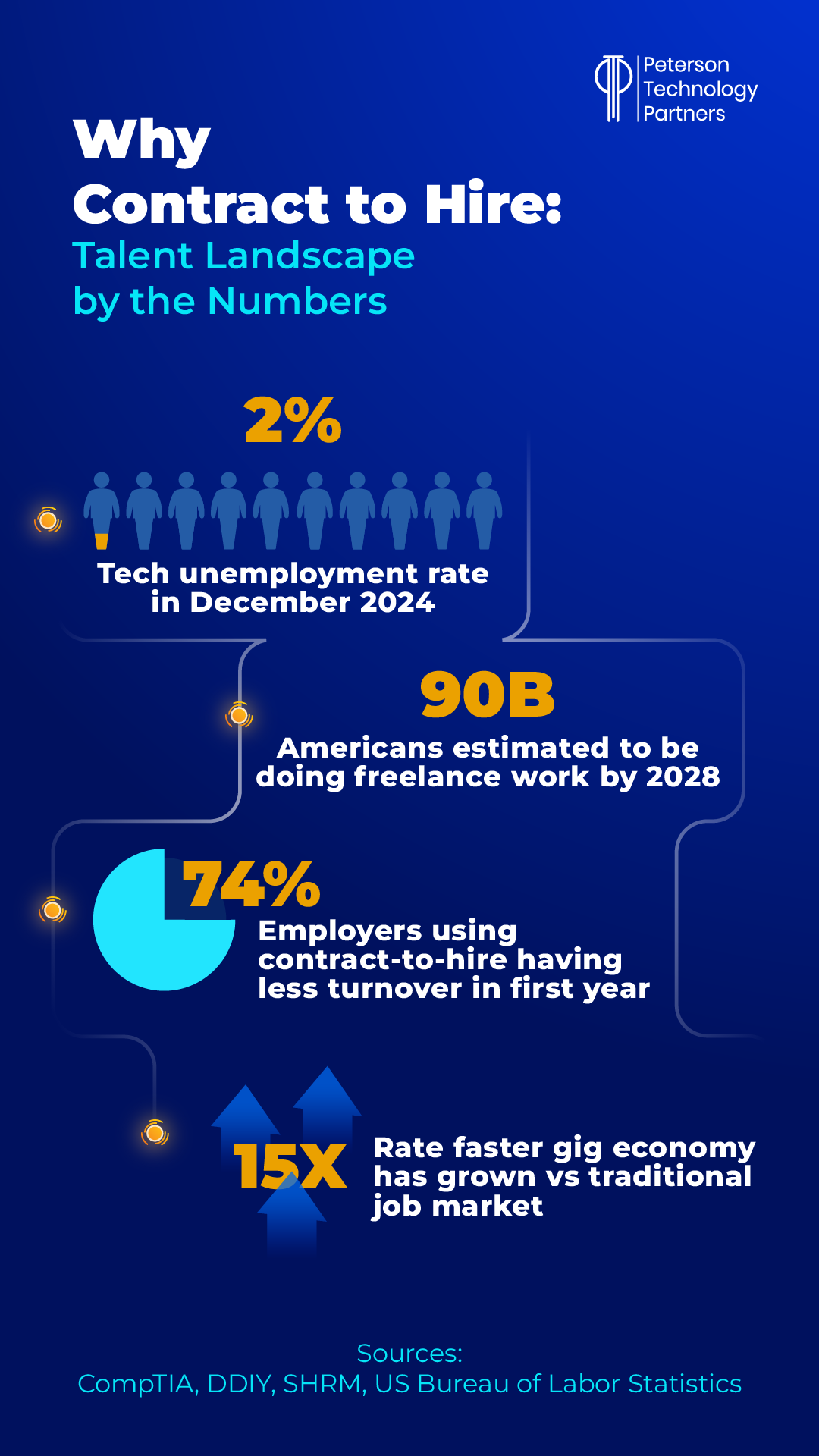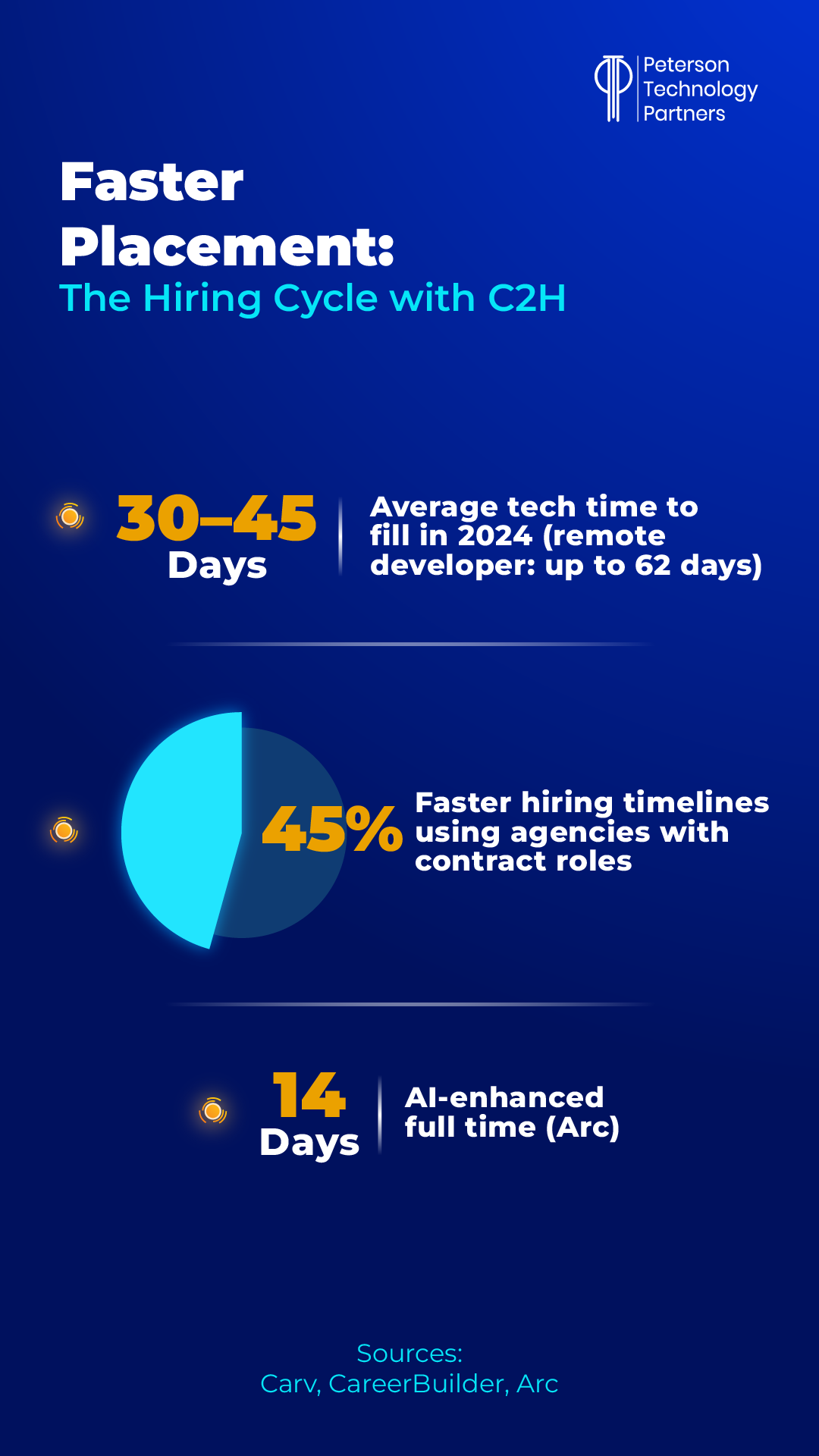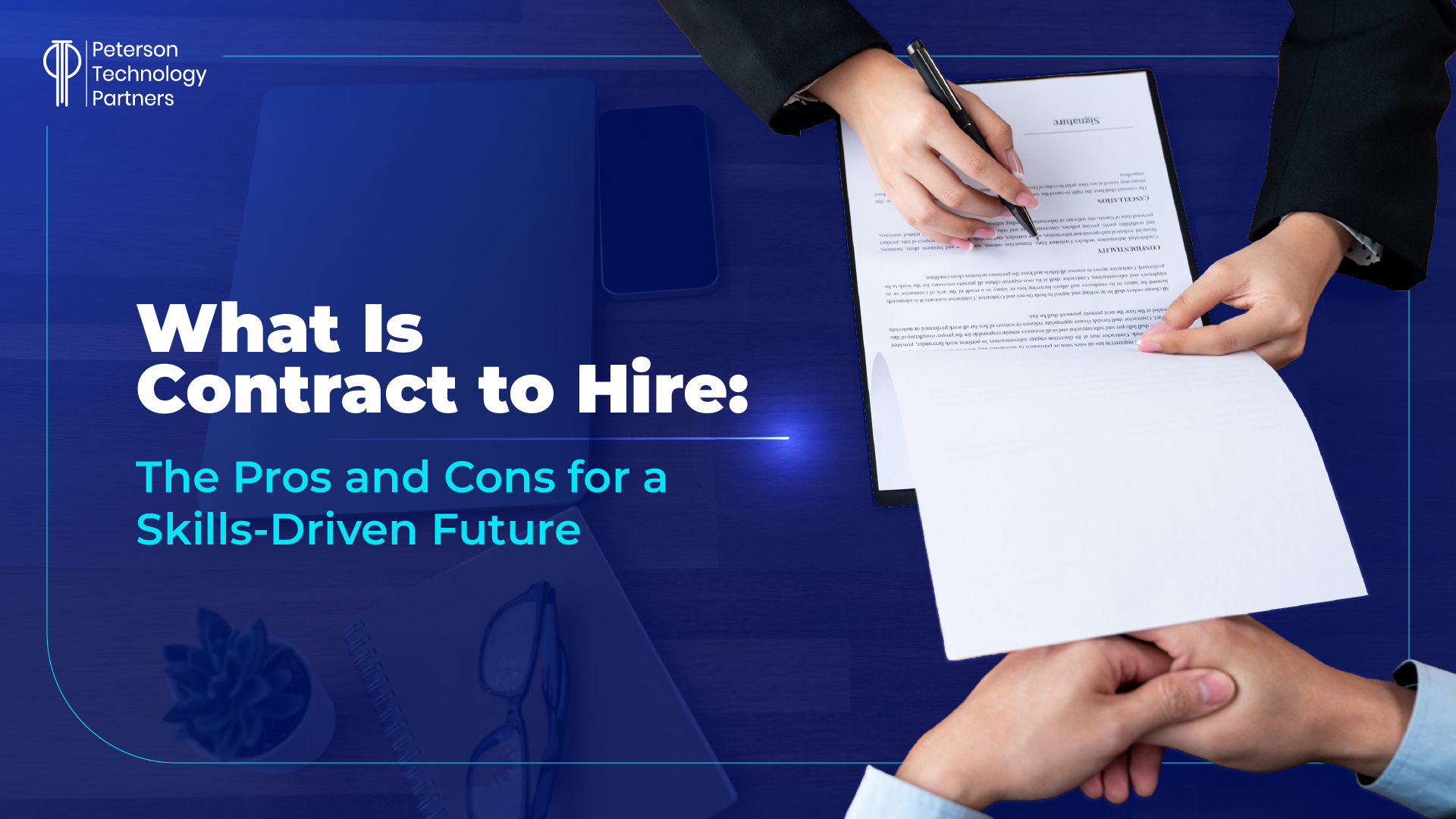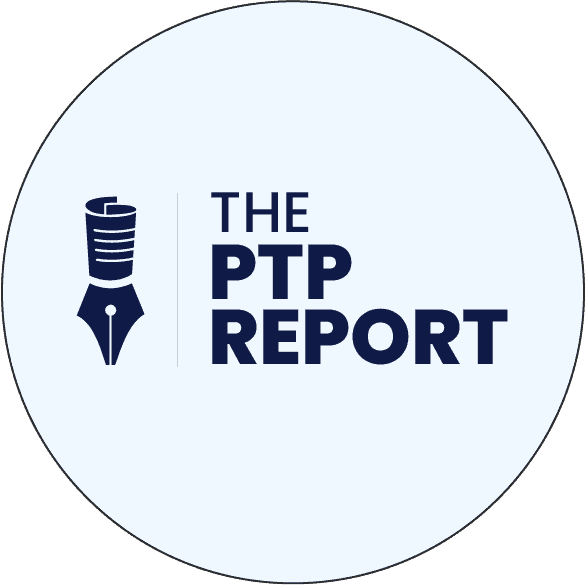Is your hiring cycle just too slow? Are you losing out on talent with the hottest skills on the market, or do you have a critical gap in areas like AI implementation experience but are uncertain how many people you can afford to keep long-term?
For workers, do you want a bigger name on your resume or brighter opportunity than you’re getting with your regular applications? Is your resume unconventional, or are you lacking experience with new skills?
These are some of the situations where contract to hire is emerging as a go-to option in tech.
With the average worker holding more jobs in their lives (twice as many, per the World Economic Forum), in positions that didn’t exist 25 years ago (like 20% of job listings today), not to mention rapid skills turn-over and fast-moving technological changes, mobility and volatility remain high for many areas of tech.
In today’s PTP Report, we look at what contract to hire looks like in 2025, reasons we’re seeing a spike in such flexible hiring solutions, the impact of AI in the process, and the pros and cons for businesses and talent alike.
Contract to Hire’s Meaning Today
Freelancers make up a significant slice of the global workforce, and the contingent workforce in the US, measured by the US Bureau of Labor Statistics as people who do not have a contract for ongoing employment in their jobs, is only growing.
Add it with so-called alternative work arrangements (like independent contracting, on-call, temp help agency, and workers provided by contract firms), and it makes up 14.5% of the total US workforce.
Emerging among these tech staffing strategies is contract to hire (C2H).
A C2H engagement begins like any contract position, with a worker signing on for a fixed span (say 3–12 months) and typically paid through a vendor.
But unlike other contract positions, the C2H contract includes a special clause indicating a company’s interest in converting the position to full-time, based on performance and ongoing business needs.
C2H is a way for businesses to get potential full-time talent on site and on the job for a hands-on trial, and for workers to get a chance to show what they can do in action.
Unlike gig workers, C2H tech workers are typically embedded within teams, push code to the core repos, and are evaluated on the same metrics as more traditional staff.
But unlike traditional staff, C2H means holding off on other full-time benefits and obligations, like healthcare, retirement matching, and potential company stakes.
It is like an extended test for both sides to see if the fit is right.
Increasingly C2H is moving from an approach of necessity used by startups and staffing agencies to a mainstream hiring option for companies of all sizes.
Behind Contract to Hire’s Recent Surge
Before we get into the benefits and drawbacks, let’s look at some of the reasons why C2H is an increasingly popular form of tech hiring:

There’s a significant skills turnover underway in the US workforce which is seeing a rise in soft skill importance (+20% since 2018, per the World Economic Forum), and a broadening of skills that workers are bringing to the table overall (+40%).
There are also notable skill gaps emerging, especially for in-demand areas like AI/ML and cybersecurity, and experience with things like Kubernetes or building AI agents.
With overall tech unemployment on the low side, and demand high, prized talent can go fast, putting pressure on companies to get people under contract ahead of the competition.
C2H is one way companies can get talent on the job more quickly than through a traditional vetting process.
With more workers overall wanting greater flexibility, C2H gives them a chance for a trial run, too. The surge in remote work has also helped open the door for more adaptive hiring approaches like C2H.
C2H can also be an intriguing option for offshore tech, giving companies time to get up to speed with local labor laws and ensure compliance with cross-border hiring before making it permanent.
It can also allow companies to tap into nearshore staffing benefits (closer proximity, overlapping time zones, and reduced cost) more quickly and assess the fit and (as with offshore) the regulations, all while maintaining the option to convert to full-time.
Contract to Hire Pros and Cons
C2H is faster and more flexible than traditional full-time, but it’s not for everyone or every situation.
For Employers: Improved Workforce Agility in Tech
We believe we’re seeing contract to hire among the tech recruitment trends in 2025 for companies of varying size largely because of flexibility.
At a time when adaptability is highly desirable, C2H gives employers the ability to try out staff on-site, in their roles, and observe integration first-hand. It reduces the time to hire overall, leads to less turnover than regular contract or non-traditional/alternative arrangements, and gives added room for budget fluctuations.

C2H also gives businesses greater freedom to pivot as needed, especially when looking for highly specialized skills they may be uncertain if they can afford long-term.
It can be a great fit as well for trial runs in areas like AI/ML, where the need may be to get a proof-of-concept together quickly, to meet compliance pushes, or handle demand spikes of uncertain duration.
Issues to Consider in Contract to Hire vs Contract vs Full-Time Tech Hiring
But while it’s flexible and enjoys less turnover than regular contract positions, C2H is unquestionably less secure than traditional full-time hiring.
While companies may save costs from a protracting hiring process, they can also miss out on the benefits of that vetting, and team integration can be harder, with C2H workers sometimes finding themselves excluded by full-time teammates.
There is also less stability, which can mean lost costs from knowledge transfer and onboarding, and potentially less loyalty due to the open-ended nature of the contract.
This can expose companies to greater security concerns and can also reduce the size of the applicant pool.
While C2H can include high-level positions with extensive experience, it is also sometimes avoided by those who want guaranteed equity or are concerned about being strung along only to be released at the end of the contract.
Finally, while the length of commitment and full-package costs may be lower up-front, costs can still creep up, with agency fees and potential overlap among incoming and outgoing talent.
This can make it a poor choice for companies who have a long onboarding or ramp-up process, stiff regulation requirements, or for roles that involve stewarding ongoing resources such as databases, documentation, system architecture, or in security oversight.
The C2H Impact of AI in Hiring
Like everything else in hiring, AI is impacting the surge in C2H.
As a hiring approach that already offers more speed, AI is able to push it still faster, accelerating the turnaround of getting people into roles.
One extreme example is Capita, a British outsourcing provider that’s harnessing AI agents through Salesforce to reduce their seasonal hiring process from weeks to just hours.
Their AI solution, built in the early months of 2025, automates some 200 tasks in their process to create shortlists of ready candidates. Their recruiters then focus only on final interviews and making the placement.
AI-powered systems also increasingly handle pre-screening and even conduct some interview stages, and for software engineering jobs, they can pull applicant data from sites like GitHub, LeetCode, and Kaggle to accelerate the evaluation process.
AI solutions themselves are also driving the need for C2H for companies, with a push to land quality skills fast and with greater flexibility.
For Tech Workers: What Is C2H Employment Like?
On the job-seeking side, C2H’s main allure may be the prospect of working somewhere, or in a position, of uncertain fit. Many who embrace C2H do so seeking positions they might otherwise find harder to land.
This gives them a chance to prove they can do it while also learning on the job.
The drawback is that C2H lacks the security offered by full-time employment.
The very adaptability that makes it appealing for companies can be frustrating for some workers who worry about never being given the offer to stay on full-time.
It can mean higher hourly wages and even overtime pay but likely will exclude benefits like 401k matching or healthcare starting out.
There is unquestionably greater freedom, but at the cost of higher stress during the “prove it” period.
For talent, it’s also unwise to take a C2H role in cases where you are unlikely to want to stay at the end of the contract, as you may get offered the job sooner than you expect. Traditional contract work is more suitable in such cases if available.
Getting Started with the Contract to Hire Process
In terms of the hiring process, it often begins with a hiring manager defining a contract for hire need within a tighter scope (i.e., a limited number of sprints on a specific project).
This request for contract to hire services goes to a staffing vendor, who matches the appropriate candidates (now with AI heavily involved in the early phases of this process). Depending on their system, this can mean identifying quality contract talent fast.
From a shortlist, there are technical interviews and culture-fit considerations, but the contract to hire position means qualified talent gets on the job fast, pay-rolled by the source agency. The agency handles the explanation for what is a contract to hire, and during the contract window, performance data can typically feed back into the system, helping HR teams have the needed information for whether to convert.
How Does Contract to Hire Work at PTP?
At PTP, we have nearly three decades of experience matching tech talent with companies in a wide variety of ways, onsite or off, onshore, nearshore, or offshore. This includes the option for contract to hire.
We’ve seen C2H be the perfect fit in the right situations, but to increase its chances of success recommend that companies:
- Fully integrate C2H employees from the start to avoid ongoing isolation or separation in teams.
- Set explicit conversation timelines and metrics, to put everyone’s minds at ease. Ambiguity rightly causes more potential candidates to think twice and increases the anxiety of those who sign C2H contracts.
- Onboard C2H as much like traditional, full-time roles as possible. Use the same communication channels, the same code review process where possible, and the same workflow processes. This not only encourages good fit, but it also gives you a chance to make a better evaluation.
- Move on quality candidates fast. Once you’ve seen them succeed on the job, don’t wait until the trial period ends to offer them the position, unless it is absolutely necessary. Remember the trial is a two-way street, and talent with other options may exercise them if left hanging for too long.
- Use AI to help blend talent and bridge skill gaps. AI can be a great leveler for new additions with less experience in their core area, especially if they bring AI experience to the table.
Conclusion
Contract to hire is no longer mostly a move of necessity, but rather an option for companies of all sizes to find the talent they need in the way they need it.
With skill needs changing fast and technology even faster, C2H can be an appealing middle path for companies and workers both looking to get on the job fast. It gives employers the flexibility they need and both sides a trial run to prove the fit and feel confident.
Ultimately, it may also prove essential to land the person you need or get a critical project on its feet before it’s too late.
References
Contingent and Alternative Employment Arrangements Summary, US Bureau of Labor Statistics
AI is shifting the workplace skillset. But human skills still count, World Economic Forum
Capita to roll out AI-powered recruitment this summer, Reuters
FAQs
How long do most contract to hire evaluation periods last?
It depends on the situation, but most last anywhere from three months to a year. Some companies opt for a shorter period, such as three to six months, in a push for faster resolution.
During this phase, the employee works as a contractor, typically through a vendor, allowing both sides to further evaluate the fit.
Who handles payroll needs, taxes, and benefits during the contract phase of C2H?
In most situations, a staffing provider stands as the employer of record for the employee during the contract period. This means they issue paychecks, withhold for taxes, and may even offer healthcare options.
But the decision and classification should be discussed and vetted carefully, as misclassification can trigger penalties or back-taxes.
Is contract to hire (C2H) cheaper than hiring an employee full-time from the start?
Upfront, C2H is definitely cheaper.
Healthcare and other benefits are deferred, though companies will likely pay an agency markup. Once a conversation happens, there is also typically a one-time fee as well.
It can also protect companies from the expense of making a bad hire and has less turnover than regular contracting.





